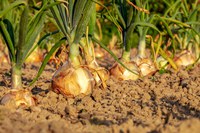Dakota Gardener: How to Grow Giant Onions
(Click an image below to view a high-resolution image that can be downloaded)
By Tom Kalb, Horticulturist
NDSU Extension
Do you want to grow giant onions? Now is the time to start making plans.
Here’s the secret: Giant plants make onion bulbs. Your onion plants need to be big when they begin to form their bulbs. Bulb formation begins in late April to early May in North Dakota.
We want our onion plants to have as many leaves as possible in the spring. That’s because every leaf creates a ring of onion. An onion plant with lots of leaves will have lots of rings - and a bigger bulb.
Select a variety that forms giant bulbs. We grow long-day onions in North Dakota. These onions form bulbs when days are 14 to 16 hours long.
'Ailsa Craig' is famous for growing the biggest bulbs. Many seed companies offer it. If you want to win the blue ribbon at the county fair, grow ‘Ailsa Craig.’
Due to COVID-19, ordering seeds early is a good idea. Garden seeds are in high demand and shipping delays are common.
You can grow big onions using seeds, transplants or sets. Seeds should be sown in flats in mid-February. Sow seeds thickly and later thin to about 1/2 inch apart. Clip the tops once they grow 5 inches tall.
If buying transplants, look for those that have a diameter the size of a pencil.
Sets are generally used for growing green onions, not giant bulbs. If buying sets for growing bulbs, look for sets with diameters of 0.5 inch or less.
You may think a large set will lead to a large bulb. This is false. Compared with a small set, a large set is more likely to bloom, which leads to a small bulb.
Let’s prepare a fertile soil bed. The soil should be well drained and loose. A sandy loam is ideal. Raised beds work well. Hard, compacted soil will restrict the growth of the bulb. Add an inch or two of peat moss, compost or other organic matter if needed.
A soil test will tell you the fertilizer you need. One general guide is to apply 1/2 cup of 10-20-10 per 10 feet of row before planting. One or two side dressings of urea (46-0-0) at a rate of 1/3 cup per 10 feet of row may be applied in early to midsummer. Fertilizations in late summer should be avoided because they lead to thick stalks and poor storage qualities.
Giant onions require full sun. Plants get their energy from the sun and we want our onions to get as much solar power as possible. Onions tolerate light frosts and typically are planted outdoors in late April.
Giant bulbs need lots of space. Crowding the bulbs will limit their growth. Plants should be spaced 4 to 6 inches apart in rows spaced 12 to 18 inches apart. They may be planted in double rows or multiple rows per bed. If you plan to harvest some of the plants as green onions while young, space the plants 2 inches apart in the row and thin as needed.
Giant bulbs need irrigation. Onions have shallow roots and struggle in dry soil. The planting should receive 1 inch of water every week either from irrigation or rainfall. The availability of water is especially important while the plant is growing its bulb. Some gardeners increase watering to 1.5 inches every week during this stage.
In the fall, you will harvest the biggest onions you have ever seen. Enjoy slicing them for sandwiches or making giant onion rings. I can’t wait for the gardening season to begin. Good luck!
For more information about gardening, contact your local NDSU Extension agent. Find the Extension office for your county at https://www.ag.ndsu.edu/extension/directory/counties.
NDSU Agriculture Communication - Jan. 19, 2021
:Source: Tom Kalb, 701-328-9722, tom.kalb@ndsu.edu
:Editor: Ellen Crawford, 701-231-5391, ellen.crawford@ndsu.edu




